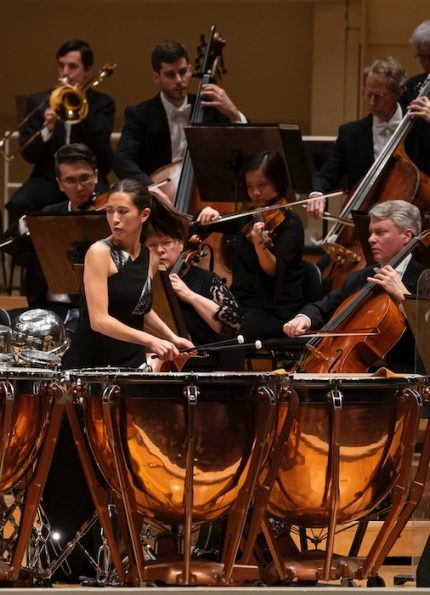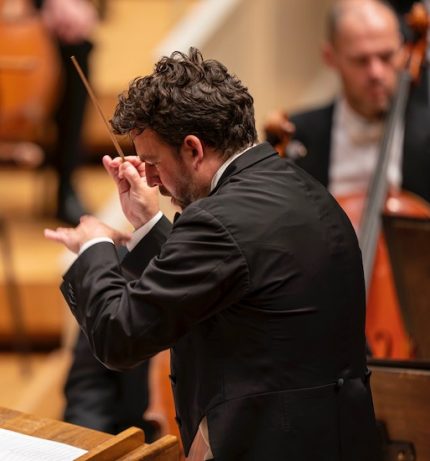A percussion debut and powerful Shostakovich from Gaffigan, CSO

One will look in vain for a nexus between the two works on Thursday night’s concert by the Chicago Symphony Orchestra—a percussion concerto premiere and a bleak wartime symphony by Dmitri Shostakovich.
If the programming didn’t quite cohere, the CSO deserves kudos for stepping outside its comfort zone with a bit of unorthodox programming. Under the direction of guest conductor James Gaffigan, both works came off surprisingly well.
The first half of the concert was devoted to Eternal Rhythm by Avner Dorman. Unveiled a year ago in Hamburg, the Israeli composer’s concerto was presented Thursday night in its U.S. premiere with CSO principal percussionist Cynthia Yeh as solo protagonist.
A substantial work at 25 minutes, Eternal Rhythm is cast in five unbroken movements. As per the genre the soloist is called upon to perform on a variety of far-flung hammered instruments including timpani, melodic tom-toms and cowbells.
Yet Dorman deftly avoids most of the standard percussion-concerto tropes. His engaging score is skillfully varied, melodic, and effectively deployed between the soloist and orchestra.
Rather than presenting the usual spectacle of a soloist dashing between a bestiary of instruments, the composer focuses most of the solo writing on the crotales, vibraphone and marimba—often for extended passages, which cuts down on the footrace around the stage.

In fact, soloist and orchestra are on an equal footing throughout Eternal Rhythm, to the music’s benefit. An ominous tam-tam strike opens the concerto, soon contrasted with an introduction of harmonic overtones, which serves as a bridge of sorts between sections. In the first movement, the soloist plays crotales, which lends a high shimmering quality. The tempo accelerates and the Balinese gamelan style seems to channel Lou Harrison at times, leading to a fast drumming section by the soloist.
The second movement is a kind of pastoral idyll—relaxed and mellow with a beguiling naive lyricism and some delicately diaphanous sounds conjured up by the soloist. The middle movement provides immediate contrast with hard-driving music of jagged angularity played on timpani and drums. The marimba is to the fore in the bravura finale, fast and exhilarating music that closes the concerto with a display of solo brilliance that the composer says represents “life, energy and an ever-present and eternal rhythm.”
Ironically, the one part of the concerto that fell flat Thursday was the fourth movement, which Dorman calls “the heart of the piece.” The music is set to the words of an 11th century Hebrew poem by Yehuda Halevi, which connects the rhythms of daily life with the (eternal) rhythm of the universe. The soloist is given the option of singing the vocal line or performing it on the vibraphone; Yeh chose the latter but the instrument’s blandly ping-pongy timbre in no way conveyed the expressive depth or metaphysical thrust of the text.
That apart, Cynthia Yeh was a vital and conscientious solo protagonist, though at times one wanted more fiery virtuosity, as well as greater power and sonic punch for the solo line to be heard over Dorman’s rambunctious orchestra.
Gaffigan led a well-prepared and alert accompaniment by Yeh’s orchestra colleagues. Dorman’s concerto proved a big hit with the audience, earning warm applause and vociferous cheers and repeated curtain calls for Yeh and the composer.
Completed in 1943 at the height of World War II, Shostakovich’s Symphony No. 8 clearly reflects some of the contemporary milieu of the embattled Soviet Union. Yet—while there is a cottage industry in over-interpreting every Shostakovich work as a crypto-manifesto against Stalin—it’s still hard not to feel that the seismic struggle reflected in this dark, roiling, hour-long score is as much about the enemy within as the enemy without.

Gaffigan led a taut and concentrated performance that indicated he knew where he was going in this sprawling yet intricate work. He kept momentum to the fore in the vast 25-minute opening movement, even though some parts of the orchestra were slow to get on board. Violin playing was polished but oddly lacking in dramatic cut and intensity in the big sweeping string phrases. There was ample sonic impact in the massive chords at the climax of the movement, which were unsettling in their grinding discordant violence. Unfortunately, while the crucial extended English horn solo by Scott Hostetler was technically accomplished, it was almost perversely bland and expressionless, conveying little sense of desolation or a fragile voice in the wilderness.
The performance—and the responsiveness of the musicians—improved as the epic work unfolded. The woodwinds provided apt rawness and edge to the unsettling martial rhythms of the Allegretto. And the ensuing Allegro non troppo went with malign, machinelike energy, new principal trumpet Esteban Batallán throwing off the middle section’s crazed, high-flying solo with big tone and wonderful swagger.
Gaffigan’s direction was most impressive in the challenge of the connected final movements—plumbing the deep interior rumination of the Largo’s hushed variations and making the final Allegretto into much more than just an amiably galumphing irrelevance. Indeed, with the reprise of the explosive opening sections firmly marked, the finale seemed for once all of piece with the preceding movements, as the music haltingly works its way to a small sense of hopeful solace in the hushed closing bars.
That quiet closing section was finely controlled by Gaffigan and beautifully played by all sections, the ensuing silence held by the conductor to strong effect. A powerful and illuminating Shostakovich performance from Gaffigan and the orchestra, with Batallán and his trumpet colleagues, piccoloist Jennifer Gunn and all four flutes among the standout contributors.
The program will be repeated 8 p.m. Friday and Saturday. cso.org; 312-294-3000.
Posted in Performances



Posted Oct 05, 2019 at 7:15 pm by H.C.
Went to this concert Friday night. Cynthia Yeh was marvelous in her solo performance. Shostakovich 8 was performed wonderfully. With nearly all of the principal player positions filled (except principal violist), the orchestra sounds fabulous. The new principal trumpeter is a true gem – a must-see for brass enthusiasts. This is a great time to go out and listen to the CSO, so get out when you can!